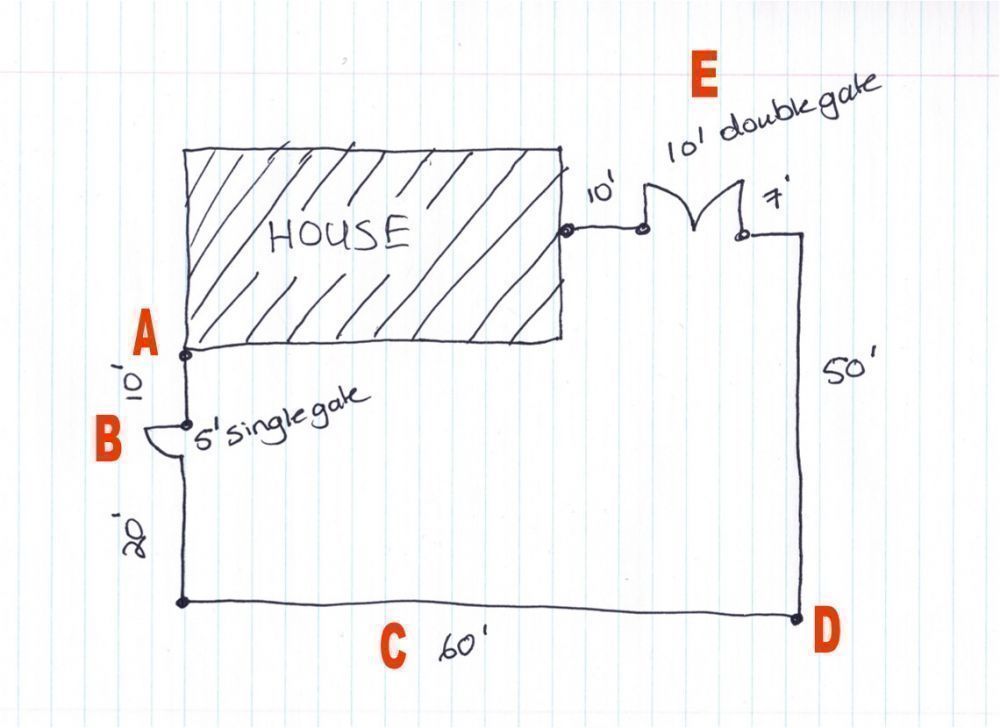
How to Draw a Fence to Get a Quote
If you’ve been trying to get a price for a fence project, you’ve probably discovered that most fence companies don’t like to give prices per foot or meter, and they don’t like to give rough estimates. There’s a good reason for that – every corner, end and change of direction can add to the cost of the fence. You might find that the fence companies ask for a drawing – but if you’re not sure how to draw a fence, which could be tricky.
We’ve created a quick and easy guide to how to draw a fence to get a quote, so you can get a more accurate price for your project.
You Will Probably Still Need a Site Visit
While a fence layout drawing can help fence companies to give you a more accurate quote, there are still some things they will need to confirm during a site visit. Things like access to your fence line, what kind of fence you have to have removed in order to do the installation, and whether there’s a lot of vegetation along your fence line all make a difference.
When fence companies visit your site, they will also look for obstacles along the fence line and any other issues that might change the quote. Slopes, paving, and many other things can all affect the installation of your fence and the price for the job.
What Should You Include In Your Drawing?
Let’s get down to the details of how to draw a fence to get a quote based on the sample sketch we’ve made. As you can see, it’s not very technical or detailed, but it will give fence companies much of the information they need to give you a price. Let’s look at each element in the drawing.
A – End Posts
When you do your fence drawing, make sure you make note of any ends and end posts. These could be, like this example, alongside a building, or they could terminate at an existing fence.
End posts require additional tensioning equipment, and they are usually larger and heavier duty, so they do cost a little more than an ordinary line or intermediate fence posts.
B – Single Gates with Sizes
The next thing you will notice on our drawing is that we have indicated that there is a single gate and provided a size with it. This not only affects the gate price but also the type of posts that will be used for the gate and sometimes the hardware. It’s important to indicate the size of all single gates on your drawing.
C – The Length of Each Fence Line
It’s very important to include the length of every fence line your project will require. Line posts or intermediate fence posts are installed at standard spacing, which is determined by the specification for each fence type. Fence companies will need to calculate the number of line posts per fence line to ensure they account for all posts, fittings, concrete and labour.
D – Corner Posts
It’s important to mark all corners on your drawing. Like end posts, corner posts are usually larger and have more fittings, so they cost a little more than line posts or intermediate fence posts. Some corner and end posts also require bracing, which will increase the cost per unit as well.
E – Double Gates
Like single gates, you need to include any double gates on your drawing, as well as the width of the gate. This will help the fence company to ensure they allow the right type of posts and fittings. If you want to have a sliding or cantilever gate, you can also make a note of that on your drawing.
Why a Good Fence Drawing Matters
A good fence drawing allows fence companies to assess whether they can help you with a quote, first and foremost. Some companies only do jobs that are bigger than a certain size, and some only do smaller jobs.
Providing a fence drawing will also let your fence contractor refer to the information provided when they do a site visit. Instead of having to start from scratch, all they will have to do is confirm details and add notes about site conditions and so on.
However, while fence drawings can definitely be a help, as can site inspections, they don’t mean that the fence company will be able to take everything into account. There might be things like underground services, hard ground or a very high water table that might change the installation method or require additional services or materials. That means that even if you get a quote based on your fence drawing and a site visit, there could still be additional costs.
Most fence companies do their best to provide customers with accurate, all-inclusive quotes, but it’s not always possible to take every possibility into account. The best thing you can do is provide as much information as possible and learning how to draw a fence for a quote is one of the first steps you can take. Hopefully, this article has given you information about how to get started!


